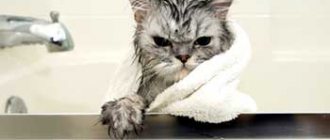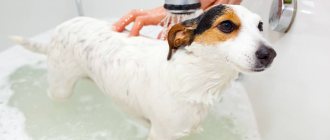Is it necessary to wash cats?
If the cat can handle grooming on its own, you don't have to bathe it. Most breeds do not need additional hygiene procedures. This applies, for example, to British and Scottish fold cats. Long-haired dogs sometimes need help, because... It is difficult for them to remove dirt on their own. Sphinxes require special care due to their unusual structure.
They try to bathe cats only when necessary. For example, when they get dirty.
Animals that have access to the street are washed more often because... they carry dirt, dust and insect larvae onto their fur. If the cat is short-haired and permanently lives in the house, you don’t have to bathe it if there is no smell.
How often
The maximum interval between baths can be anything, since most cats do not need regular bathing. Animals that visit the street are given hygiene procedures every 1-2 months. The rest are bathed when an odor or dirt appears.
The minimum gap is more important. You can’t bathe your pet too often, because... During each procedure, the protective layer is washed off from the surface of the skin. If you wash your cat too regularly, your cat's sebaceous glands begin to secrete more oil. As a result, the fur quickly gets dirty, and bathing has to be done more often.
Later, dandruff and itching appear. The animal begins to scratch itself. Due to the disruption of the skin's barrier function, infection becomes easier.
Oily wool creates optimal conditions for the development of bacteria: it is too dense and makes ventilation difficult, and moisture evaporates from it less easily. This is fraught with the development of dermatological diseases.
If you are going to bathe your pet with plain water, this can be done every 3-5 days. It is better to use shampoos no more than once every 2-3 weeks. It is advisable to carry out hygiene procedures as rarely as possible so as not to harm the cat.
How to train
To accustom your animal to bathing, follow these recommendations:
- Get your cat interested in jumping into the bath. Let her just walk around inside the first few times. Don't turn on the water. You can cover the bottom with a towel to prevent the animal from slipping. Many cats are frightened by unstable surfaces.
- Add water gradually. At first it should be a weak stream. Next time you can wet the towel. Only then can you turn on the water so that it reaches the animal’s paws. Stroke and calm your pet during the process.
- Control your stress levels. If your pet is nervous but tolerates it, continue. In case of direct aggression and active attempts to escape, it is better to let the cat go. There is no need to force her to get used to the water. Everything should happen naturally.
- Praise and reward the animal. After each procedure, offer a treat. Try to create positive associations.
- Minimize stress. If your cat is scared by the noise of the shower head, use a jug to water it. Do not take too much water: the animal will be afraid of drowning. It is better to refuse a hairdryer at least during the first procedures. Most often, pets do not like loud sounds and strong air flow.
How to prepare a cat for a bath
Before carrying out the procedure, it is necessary to prepare the work space: place shampoo and a large terry towel within easy reach. You should also set a comfortable water temperature - about 39 degrees. Under no circumstances should you wash your pet in cold or hot water.
To reduce the noise produced by water, you should first fill the bath with a small amount of water and also reduce the shower pressure, in which case the cat will experience less stress and will tolerate bathing better. The ideal option is to stop using the shower. To do this, you need to prepare a sufficient amount of warm water and a ladle or small saucepan with which you can water your pet.
About one day before the planned bathing, it is recommended to comb your pet thoroughly so that if water gets in, lumps and tangled strands do not form.
If the cat is about to have its first bath, it is necessary to calm it down and avoid loud noises and screams that could frighten it. It is also recommended to carry out the procedure together - one person holds it, the other washes it.
It is recommended to place a rubber mat or terry towel at the bottom of the bath to prevent the cat from slipping on it.
Before placing the cat in the bathroom, shampoo is poured into a specially designated container and diluted in water to form abundant foam.
Rules for washing pets
Handle your pet carefully during the procedure. Do not throw your pet into the bathtub. Try not to hold forcibly. Avoid getting water in your ears, as... this can trigger the development of diseases.
When swimming you need to do the following:
- Prepare in advance. During the washing process, you will not have the opportunity to go to the next room for shampoo or a towel, so immediately take everything you need with you. It is advisable to ask an assistant to hold the cat so that you can do the actual bathing. Before hygiene procedures, it is better to trim the animal’s claws. This minimizes the risk of injury.
- Start swimming. Adjust the temperature. Place a net or towel on the bottom to prevent your pet from slipping. Place the animal on its paws and wait. If you are using a restraint, just let your cat stand there for a few seconds. During this time, he will understand that nothing threatens him. If you have not restrained the animal, caress and stroke it. Once your pet has calmed down, you can begin to wet its fur.
- Use detergents. If the wool is clean, you can skip this step. It is better to distribute the shampoo with a massage brush. Special products do not foam; they are kept on the wool for some time, then washed off. It is best to minimize contact with shampoos if possible, because... For cats, washing is an unnatural process. This causes them stress.
- Rinse off the shampoo. Residues must be removed carefully, otherwise they will irritate the skin and cause itching. If you use not only shampoos, but also conditioners, rinse them thoroughly each time. Multiple products may cause an unwanted chemical reaction when combined.
- Dry the wool. It's better to do this without a hairdryer. You can wrap your cat in a towel and hold him in your arms for a few minutes. During this time, most of the moisture will be absorbed by the fabric. After this, you can lower the cat to the floor, take another dry towel and begin to remove any remaining water.
- Comb the fur. It is better to start the last stage after the pet has calmed down. This step can be skipped if the animal does not shed, but for breeds such as Britons and Scottish Folds, it is required. They have a dense, stuffed coat that constantly sheds.
Why do you need to bathe a kitten?
Some cat owners are sure that it is not necessary to wash this pet. She can wash herself and lick herself, but bathing only harms her. Other owners are firmly convinced that this animal also periodically needs to take water procedures and this benefits them. Then another question arises: how often can cats be bathed? And if you wash your cat, what shampoo should you use?
Pet hygiene
Many people know that a cat can lick itself. Its saliva not only contains active components, but also has acidity, which dissolves any contamination. The tongue of cats is rough due to the large number of small and sharp protrusions called papillae. These animals lick themselves instinctively and, if the cat is healthy, then it always keeps itself clean.
However, dirty basements, garbage, a lot of germs, exhaust gases lead to the need to wash the cat so that it does not become infected with anything. If you don't let your cat go outside, it still won't solve the problem. Harmful bacteria enter the apartment along with human clothing, but such completely domestic cats should be washed less often than walking cats.
Lifestyle Features
Cats that are not allowed outside are bathed once every three months, and the owner must also brush her periodically. If the owner lives in the city, then a pet that walks in the yard every day should be washed once every one and a half to two months.
An animal living in a village and walking along rural streets is washed three to five times a year. Hairless cats should be bathed more often - every two weeks in summer, once a month in winter.
The following recommendations must be followed:
- Many owners do not know at what age to bathe a kitten. Of course, early accustoming to water will allow you to bathe an adult cat without any problems in the future. But it is worth knowing that temperature changes have a bad effect on tiny kittens. It is better that in the first months the mother cat takes care of their cleanliness. After the baby teeth fall out (4 months), you can wash the kitten for the first time;
- How often should you bathe a kitten? It depends on his reaction to the first bath. It’s good if he is not afraid of water and will happily jump into the bathtub. If a kitten plays with water, you should not scold it. But still, most animals do not like water procedures, so the kitten should then be bathed after changing its milk teeth;
- Adult cats need to be washed 2-3 times a year. The number of baths depends on the breed. Persians, especially pure white and peach ones, can be washed once every 2-3 months. Breeds such as British Teddy and European cats do not require water treatments at all The Sphinx is only wiped with a wet cloth;
- You should not bathe cats if the room is very cold. A wet animal can easily get sick. It is not advisable to wash animals during illness, after vaccinations, so as not to expose weakened immunity to even greater stress;
- A pregnant or lactating cat is washed if absolutely necessary, so as not to create a stressful situation.
There can be several reasons for bathing cats. Let's look at each of them in more detail.
The appearance of a kitten in the house
If the kitten was adopted from a shelter or from a domestic cat, then it is absolutely not necessary to wash it, because in these cases it must be clean.
If a kitten is picked up on the street, you definitely need to give it a bath. In this case, it is necessary, for preventive purposes, to use special shampoos.
This will not only keep it clean, but will also help identify possible skin problems that will need to be treated.
If the cat gets dirty
Not all cats are absolute cleanliness. Some may only lick the sides or wipe the head with their paw.
Therefore, the owners themselves finish what they started, giving the cat a good bath.
Also, walking cats can get dirty with dirt, dust, and bring home burrs and cobwebs on their fur. To prevent all this stuff from ending up on upholstered furniture or a bed, the animal must be bathed. Even indoor cats that never go outside can get dirty by turning over a pot of soil, carelessly going to relieve themselves, and so on.
Animal molt
Many breeds are artificially bred, so owners must take special care of them. Animals are bathed in order to soften the skin and fur, which dry out very strongly in a heated room.
Also, during shedding, only bathing can remove loose hairs , otherwise new hair will grow very poorly. With the help of water procedures, the molting process is accelerated and facilitated.
Presence of parasites
If your cat has fleas, you can wash it with flea shampoo. Some of them do not cope with this task and, in order not to wash your pet often because of this, you can use stronger products in the form of drops or sprays. They are applied to the animal’s fur and washed off after two days.
There are also veterinary shampoos with tar that treat skin diseases in animals. It should be used only as prescribed by a doctor.
Preparation for the exhibition
Elite purebred cats require appropriate care. Before various exhibitions, they are washed with special shampoos , which add shine to the coat and increase its volume. Such shampoos are very expensive, but the wool looks great.
These are the reasons why animals are bathed. But don't get too carried away with it. Many owners wash their pets on purpose to make fun of their pitiful wet appearance.
Such careless animal owners should know that they do not have sweat glands , and the amount of secretion secreted by the sebaceous glands protects against dryness.
If you bathe your cat too often, the water begins to wash away the secretions and the skin becomes dry. It becomes covered with cracks, peels off, and the hair begins to fall out.
What you can and cannot wash your cat with
It is strongly recommended to wash cats only with special shampoos. It is better to choose a product depending on the breed and coat type. It is advisable to avoid flea shampoos unless you require a preventative effect. Such products are more aggressive and contain additional fragrances, which is bad for the animal’s skin.
Do not bathe your pet using soap or human shampoo.
Humans and cats have different skin acidity levels. Shampoo for people is more aggressive, it removes fat better and dries out the epidermis more. In cats, this can cause malfunction of the sebaceous glands and the appearance of dandruff. Soap is too aggressive even for people.
As a last resort, if it is not possible to purchase a special product and the animal is dirty, you can use baby shampoo. Preference should be given to a composition with a minimum amount of additives.
Is it necessary to bathe a cat every day?
The expressions “afraid of water like a cat”, “a cat washes itself with its tongue”, “a cat cannot be bathed” are familiar to everyone since childhood. But there is some misinformation in this. Felines also periodically need water treatments. “How often can you wash a cat?” – an important question for any caring animal owner.
The need for water treatments
Cat saliva contains a special set of enzymes that dissolve any contaminants. And a cat’s rough tongue, like a brush, is capable of combing out everything unnecessary from the fur. If the pet is healthy, he always finds time to take care of himself and remains clean. At the same time, it is important not to forget how often you can bathe your cat.
If a cat walks down the street by itself, you will never be sure what places he visited. Garbage cans are a very attractive place even for the most aristocratic pet. The next hot spots, loved by all furry creatures, are basements and heating mains.
It is so comfortable in underground structures, there is so much unexplored, so many sounds and secluded places, and mice also live there. How can any self-respecting cat avoid visiting basements? Do you need to wash the cats that live at the entrance and in the basement of the house, which you feed every day? Of course it is necessary.
Will it still get dirty tomorrow? Yes, but the wool will not have the critical amount of pathogenic bacteria to disrupt the animal’s immune defense.
Cats who love extreme recreation often visit dovecotes. A dangerous activity, but so fascinating! All this is a huge part of your cat’s self-realization, but there is a side issue - microbes and protozoa that such places are infested with.
On its paws and fur, a cat can bring a huge number of harmful microorganisms into the house. How often can you wash a cat if it goes out on its own? Basic sanitization should be carried out after each busy day, and a thorough bath should be done once every month or two.
And if a four-legged miracle sits at home and doesn’t even go out into the yard, then how often can you bathe absolutely domestic cats? In this case, the pet is still not protected from contact with germs. You came home from the street, and the cat joyfully greets you at the threshold, rubbing itself against your boots.
Then you sat down on a chair wearing the same jeans you had just worn on public transport, and the cat instantly jumped into your arms. Do you see? Contact with microbes from the outside world still occurs.
Yes, the cat does not bring visible dirt from the street, but how often should the cat be washed in this case? Cats that do not go outside take water exercise once every three months.
Country yard cats also want to be healthy, so they are bathed once a season, but they are always allowed to dry for several hours in a house or other warm room without drafts.
How often should you wash a cat of breeds such as Sphynx, Lykoi, Cornish Rex and other hairless or short-haired cats? They are washed much more often - every couple of weeks. In winter, if the house is not hot, you can reduce bathing to once a month.
A special occasion for baths is the eve of an exhibition, when the pet needs to be brought into impeccable shape. Then it is better to bathe five or six days before the event, so that during this period the coat will naturally secrete and regain its shine. Otherwise, the cat runs the risk of looking shaggy and unkempt on the experts’ table.
Another moment when it is worth washing a cat is a situation where he has spilled something dirty on himself, or a delicate situation with weakened intestines in long-haired animals, when the owner’s help in maintaining cleanliness is simply necessary.
Insect control measure
If trouble happens and the cat brings fleas, then do not go to extremes, but remember that bathing with ordinary means will not help. You will need a shampoo that contains antiparasitic agents.
Important! After the cat is free of fleas, treat his sleeping place, as well as those places where he often rests.
There are a lot of flea shampoos in veterinary pharmacies. There are special shampoos for adults, and there are also for small kittens. Do not neglect what is written on the package, so as not to undermine the health of your pet or poison it.
How often should you wash your cat with flea shampoo? This should only be done when the animal actually has fleas and you want to remove them. Is it possible to wash cats with soap? There are solid soaps with the same direction of action. But they are somewhat more difficult to use, especially when the animal does not really want to stay in the bathroom.
Bathing a cat for fleas is carried out in several stages:
- Wet the cat. The water should be slightly warmer than the air temperature, but not hotter than the temperature of the animal itself (38-39 degrees).
- Rub a small amount of shampoo over the coat, massaging and rubbing for at least 5 minutes.
- Keep the cat busy with conversations in a calm tone, with a toy in the water, while the shampoo is working, do not wash it off immediately. Look on the packaging for the duration of action of this product.
- When washing off the shampoo, run plenty of running water. Rinse off the anti-flea shampoo under running water for at least 5 minutes so that there is no residue left on the fur. After all, the animal will begin to lick itself and the remaining product will end up in the stomach.
- Comb the dried cat with a very fine comb.
Important! Avoid getting flea shampoo into your animal's eyes, mouth and ears!
When looking for an answer to the question “How often should you bathe a kitten?”, remember the advice of any veterinarian - water procedures for the cat family are extremely undesirable.
When cats should not be washed
You cannot wash an animal in the following cases:
- The cat recently ate. Due to manipulations, your pet may experience nausea.
- The animal recently underwent surgery. After surgery, pets are not bathed for 2-4 weeks.
- The pet was under severe stress. Due to aggression or fear, the animal will not be able to relax. Your actions will increase nervousness. Even if you manage to wash the cat, the relationship between you will worsen. Next time the animal will resist.
- The pet is sick. In case of chronic pathologies in remission, the cat can be bathed, but in case of exacerbation, hygiene procedures should be abandoned. This is an additional burden on the immune system.
Use caution when bathing older cats, small kittens, and pregnant and lactating animals. During these periods, pets’ bodies are weakened, so stress affects them more strongly, and the chance of catching a cold is higher. It is better not to bathe kittens under 3 months of age at all. Their internal thermoregulation system does not work well. Because of a foreign smell, a cat may refuse a kitten.
Bathing a cat before a show
Demonstration performances in such events require the ideal appearance of the pet. Before the exhibition, it is advisable to wash it with pet shampoo. Comb the wool, lay it with colorless gel and fix it with varnish. Owners often ask whether it is possible to wash a cat with human toilet soap. Here the answer is clear - under no circumstances! The soap has an unsuitable pH (acid-base balance) for the animal, and there is a risk of massive hair loss and partial baldness. Then you will have to give up the competition.
Of course, some pets live without water treatments and are quite happy. However, there are situations when you cannot do without a good bath. Let your four-legged friend's bathing always take place in a calm environment. Show the cat that you can be trusted, give him a treat and everything will go well.
We hope that we were useful to you, we are always glad to see you in our hotel for cats and cats, Cat Lounge
Veterinarian advice
Veterinarians advise using a retainer while bathing. This is a suction cup with an attached collar and cord. The retainer ensures the safety of the animal and its owner. The device eliminates the need to call an assistant.
When swimming, you need to control the temperature in the room. Sudden changes should be avoided. It should be warm in the bathroom and outside. You should not take your pet into a cold room after bathing.
It is advisable to avoid hygiene procedures. If you want to help your cat cool down in the summer, use a spray bottle and lightly dampen your cat's fur. You should not bathe your pet, because... The water will make it more difficult for him to regulate his temperature. Fans are also a bad option. A draft can cause your pet to catch a cold.
In winter, if your pet's coat has become oily, you can use dry shampoo. It helps remove excess sebum without moisturizing. This method is also suitable for nervous and aggressive animals. If bathing a cat causes severe stress, but it is impossible to avoid it, it is allowed to use mild homeopathic sedatives.











